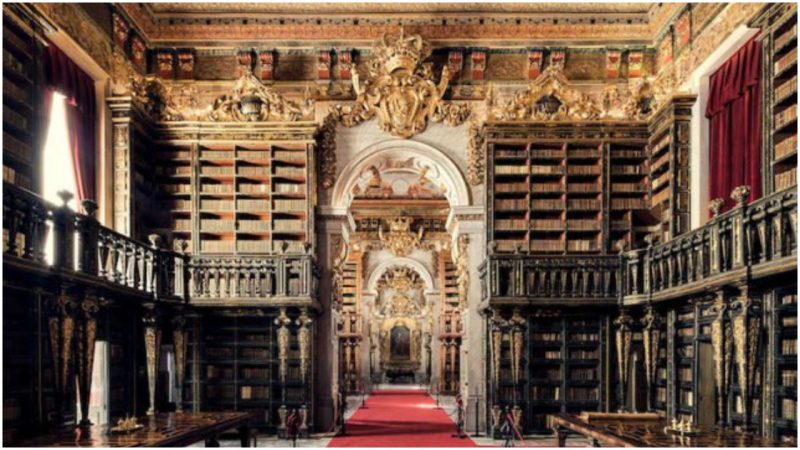Libraries are so much more than buildings that contain the history of knowledge—they also exert a powerful aura. They are places where one can escape from reality and enjoy the silence offered. You don’t even have to be a book lover to admire these magnificent buildings, as many of them are among the architectural marvels of our world.
Often overlooked, the libraries possess stunning architecture and interior design that stands as a monument to different eras, and stepping into one of them can really transport you to another epoch. However, it can be a challenge to visit some of these magnificent buildings. Thanks to Parisian self-taught photographer Thibaud Poirier, you can now glimpse inside some of the most impressive temples of cultural worship.
Poirier spent a year traveling all over Europe and eventually Argentina to capture these incredible designs. Apparently, he did a great job. His series, called “Libraries,” focuses on both historic and contemporary libraries, most of them from France. It presents Poirier’s use of symmetry in an attempt to highlight the classical values of the beautiful interiors of libraries throughout Europe and South America.

Pictured above is the Casanata Library, located at Via di Sant’Ignazio, in Rome. Established by Girolamo Casanata in 1701, it was among the most important libraries of the 18th century, housing more than 20,000 books, including rare volumes from Hebrew and Greek periods. Today, it is home to around 400,000 volumes and about 6,000 manuscripts.
You don’t have to be a photography expert to notice that Poirier paid attention to details, creating a harmonious atmosphere. This is no coincidence; he carefully selected each library for its unique ambiance and architectural features.
When it comes to such unique ambiance, Biblioteca Joanina is evidently the perfect example. The University of Coimbra in central Portugal is where this unique library stands. The Baroque library was founded by King John V and completed in 1728. Today, it houses more than 250,000 books, including some that date back to the 15th century.
Although Poirier is now settled in Paris, he notes on his website that he spent most of his life experiencing other cities and cultures across the world. “I’ve called Buenos Aires, Houston, Montreal, and Tokyo home to name a few,” he explains. It is clear that his cultural experiences from all over the world are what made him develop a love of architecture, one that eventually became an important part of his life.
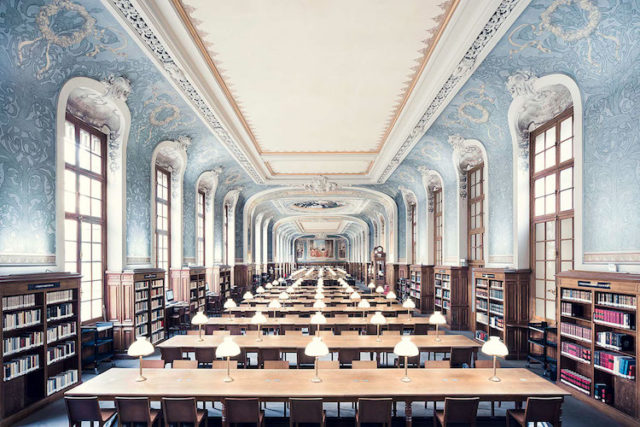
The astonishing photo above is the early 14th-century Saint-Jacques Reading Room of the Sorbonne University. It was restored at the end of the 19th century by the French architect Henri Paul Nénot and opened in 1901.
Poirier first started using a digital single-lens reflex camera, and today he shoots mostly with a Canon 6D with 17mm and 24mm TS-E lenses. According to Poirier, this allows him “to control perspective for architectural shots and to create undistorted panoramas with optimal image quality.”
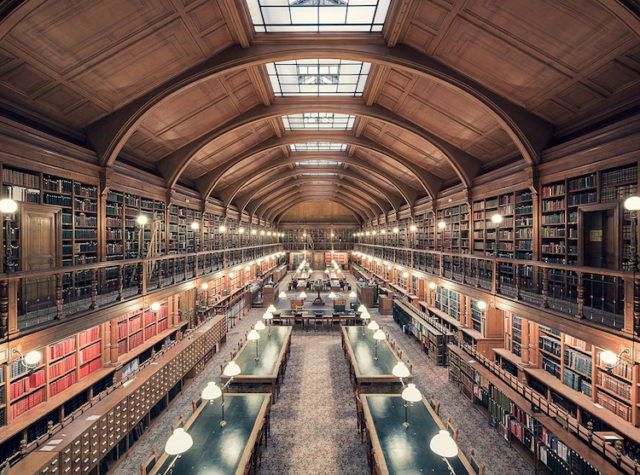
Pictured above is the reading room of the Paris City Hall Library, dedicated to the history of the city of Paris. When the city hall building opened in 1890, the library was situated on the fifth floor and it housed around 15,000 volumes. Today, it includes over 600,000 books.
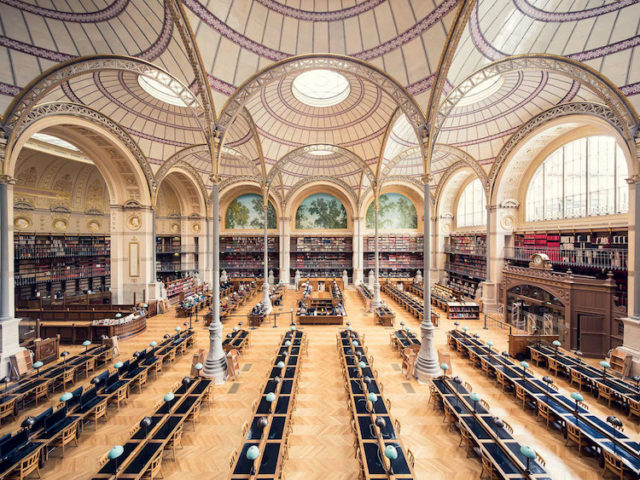
Poirier has photographed 25 libraries so far, but his mission is not yet over. He plans to add more photographs to the series.
One of those 25 libraries is the Bibliothèque Nationale de France, which houses the beautiful reading room called Salle Labrouste. It was named after the architect Henri Labrouste, who is credited with the creation of this stunning reading room.

Most of the libraries included in Poirier’s series are located in France, including the Bibliothèque Sainte-Geneviève, which contains around 2 million books.
Architect Henri Labrouste, who designed the reading room of Bibliothèque Nationale de France, is the man who also designed the glass and iron reading room of Sainte-Geneviève. The reading room which fills the entire upper story of the building was completed in 1851.
As mentioned above, Poirier embarked on an epic journey and eventually reached Buenos Aires, Argentina, where he visited an impressive bookshop called El Ateneo Grand Splendid.
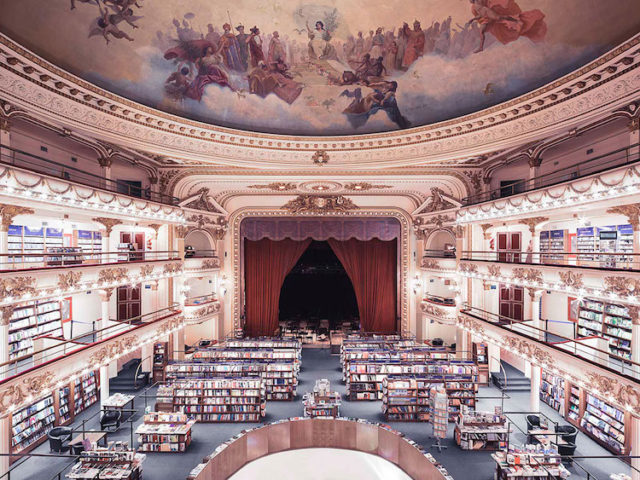
This majestic bookstore, built within the Grand Splendid Theater, which opened in 1919, currently welcomes over 1 million book lovers each year. Originally designed by architects Peró and Torres Armengol, the theater was converted into a cinema, and later in 2000 into the El Ateneo Grand Splendid bookshop. In 2008, The Guardian named it the second most beautiful bookshop in the world.

The Rococo library, situated at the back of the second floor of the neoclassical Palace of Mafra in Portugal, holds an impressive collection of nearly 40,000 rare books, including some printed before the year 1500.
Its magnificent marble floor, wooden bookshelves, and balcony with a wooden railing made this library a perfect candidate for Poirier’s series.
However, what makes this library unique is the way they keep the books from being damaged by insects. Apart from its impressive collection of rare books, the library holds a collection of around 500 bats responsible for keeping insects away from the books. During the day, the bats are kept in boxes and they are let out at night to do their job.
Poirier visited the buildings when they were closed and empty of people so he could focus completely on structure and layout.

Pictured above is the largest library in Ireland, the Trinity College Library located in Dublin. It has over 6 million printed volumes, including the Book of Kells and the Book of Durrow.
The Long Room at Trinity College’s Old Library is definitely the most impressive part of the institution, housing a huge collection that includes a copy of the Proclamation of the Irish Republic.

The Guimet Museum houses one of the largest collections abroad of Asian art and that is definitely what makes this place well known across Europe. What caught the attention of Poirier, though, is the lovely circular library. Unique for its shape, colors, and atmosphere, the library is very different from the rest of the museum.
In 1905, the famed Dutch exotic dancer and courtesan Mata Hari performed a dance in the library of the Musée Guimet.
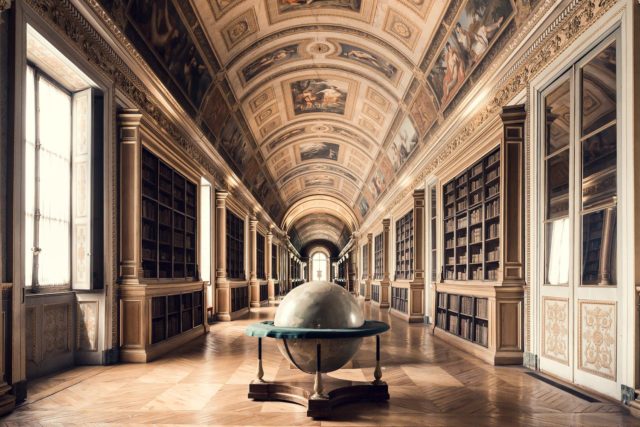
The Château de Fontainebleau is a perfect example of French Renaissance and neoclassical architectures, but what convinced Poirier to visit it is the library. Known as Diana Gallery because of the many paintings of the Roman goddess, the library is the longest room in the château, which makes it the most beautiful part of the Fontainebleau Palace.
Most of the paintings were removed back in 1853, when Napoleon III turned it into a library. Originally it contained around 4,500 books, and most of them are still there.
Photographer Thibaud Poirier’s project does not stop here and he intends to add as many beautiful libraries as possible to his series. If you liked his work, you are welcome to check out his Berlin Interiors series.
